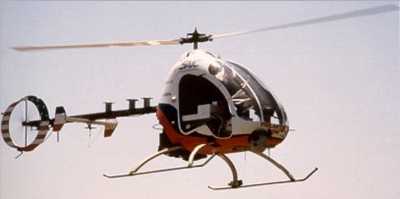So, you're stuck on one side of the ranch and you're wondering
what's up on the other side. Go there? Pshaw. Send your drone.

Some of the coolest new technology in UAVs comes from Advanced
Technologies, Incorporated. Unlike the Predator and Global Hawk,
the Vigilante family of UAVs is VTOL. And unlike the Fire Scout,
Northrop Grumman's VTOL UAV, if you want to go along for the ride
in a Vigilante™, you can. The Vigilantes can be used to
deliver supplies to marooned troops, reconnaisance, or -- who
knows? -- perhaps even to pick up of casualties from a battle zone,
all by itself.
Manned Or Unmanned: Pick Your Flavor
There are two variants of Vigilante. Both have a maximum gross
weight of 1,100 pounds, a main rotor diameter of 23 feet, an
overall length of 26 feet; their shrouded tail rotors stand eight
feet tall.
The Vigilante 496 OPV (optionally-piloted vehicle) can hit a TAS
of 75 knots; and has an operating ceiling of 12,000 feet. Although
its 12 cubic foot interior may seem a little cramped, this little
UAV can carry a payload of up to 300 pounds. That's in addition to
its full fuel load of 18 gallons. A Hirth engine gives the 496
about five hours in the air.
 The Vigilante 502 is a UAV only aircraft with a
somewhat sharper performance edge. The 502 tops out at 117 knots
TAS and can fly as high as 13,000 feet above sea level. But the
502's better performance comes at a price. Its interior capacity is
only five cubic feet and its maximum payload just 150 pounds.
Still, the 502 is designed for much better endurance, with a
36-gallon fuel capacity in a crashworthy fuel system. It's more
streamlined and boasts a Rotax 914 turbo engine.
The Vigilante 502 is a UAV only aircraft with a
somewhat sharper performance edge. The 502 tops out at 117 knots
TAS and can fly as high as 13,000 feet above sea level. But the
502's better performance comes at a price. Its interior capacity is
only five cubic feet and its maximum payload just 150 pounds.
Still, the 502 is designed for much better endurance, with a
36-gallon fuel capacity in a crashworthy fuel system. It's more
streamlined and boasts a Rotax 914 turbo engine.
Linux Is Pilot In Command
In both aircraft, the avionics system uses a high-quality
navigation sensor, an integrated INS/GPS solution, and an
integrated air data system. With all that, ATI says the machiens
have a "robust fault detection and recovery" capability. The
thinking ability of both choppers is based on a PC104-based
processor suite using proven, off-the-shelf hardware. The brains
behind the system: a low-cost, non-proprietary Linux operating
system.
Obviously, a VTOL UAV presents some rather special challenges
for any ground-bound pilot. To compensate, the Vigilantes'
operating systems incorporate special controls and displays. The
idea: meet the special requirements of rotary wing vehicles,
especially distinguishing between hovering and forward flight
modes.
The pilot has several different ways to interact with the
Vigilantes. They include real-time flight director style commands,
supervised autonomy of waypoint-based navigation, and fully
autonomous flight (for recovery after lost link).
 The Ground Control Station (right) features
redundant command/status RF links in 900 MHz and 2.4 GHz. There is
also a 72 MHz backup safety pilot command link and a 425 MHz flight
termination link. A variety of additional real-time sensing
elements are recorded by the ground station including: engine
health & status instrumentation, EGT and CHT, separate rotor
and engine speed, electrical power system status, a radar altimeter
(0-600m), and an ultrasonic ground proximity warning
system.
The Ground Control Station (right) features
redundant command/status RF links in 900 MHz and 2.4 GHz. There is
also a 72 MHz backup safety pilot command link and a 425 MHz flight
termination link. A variety of additional real-time sensing
elements are recorded by the ground station including: engine
health & status instrumentation, EGT and CHT, separate rotor
and engine speed, electrical power system status, a radar altimeter
(0-600m), and an ultrasonic ground proximity warning
system.
Mission control is done via the GCS through redundant
frequency-hopping digital datalinks having a 20 nautical mile
range. The operator may select levels of control authority over the
vehicle ranging from hands-off, waypoint inputs (from A to B at C
speed at D altitude) to joystick controlled velocity commands
(climb at x rate, turn at y rate, cruise at z rate, etc). Automatic
takeoff and land, pre-programmed lost link recovery, and emergency
autorotations are also executed without operator intervention. The
remote pilot gets a sense of where he is by looking at digital
maps, air vehicle health displays, and payload operations screens
on the GCS display. A stand-alone Flight Termination System is
optionally available.
 ANN's Daily Aero-Term (04.20.24): Light Gun
ANN's Daily Aero-Term (04.20.24): Light Gun Aero-News: Quote of the Day (04.20.24)
Aero-News: Quote of the Day (04.20.24) ANN's Daily Aero-Linx (04.21.24)
ANN's Daily Aero-Linx (04.21.24) Aero-News: Quote of the Day (04.21.24)
Aero-News: Quote of the Day (04.21.24) ANN's Daily Aero-Term (04.21.24): Aircraft Conflict
ANN's Daily Aero-Term (04.21.24): Aircraft Conflict





